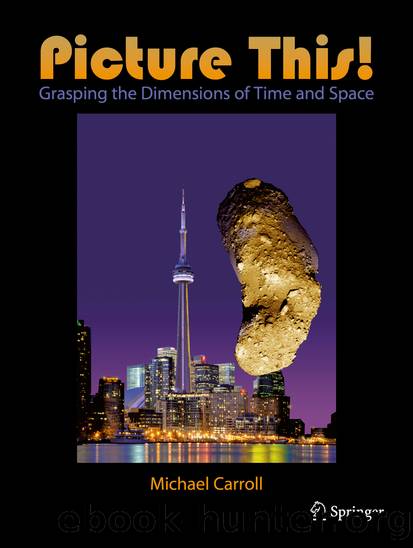Picture This! by Michael Carroll

Author:Michael Carroll
Language: eng
Format: epub
Publisher: Springer International Publishing, Cham
Earth’s Moon
The heavens used to be so simple. The first-century writer Paul spoke of three “heavens”: the first was where the birds and clouds floated; the second was where the stars wheeled; and the third was where God lived. To Ptolemy and other ancient observers, the physical universe could be broken down a bit further. Earth, whether flat or round (a source of debate in ancient times) sat in a stationary spot at the center of all things, while the birds, sunsets, clouds and rainbows existed in a sort of middle limbo between Earth and a star-embossed crystalline sphere, perfect in order and structure, as were the wandering stars (planets), Sun and Moon. Galileo’s little telescope changed all that. The Moon, it seemed, was no perfect orb, but rather had rugged mountains and circular hollows. These hollows are craters, and craters make a fine yardstick for geologists who are determining the relative ages of planetary surfaces.
We saw in Chap. 1 that even Earth has craters (for a little historical background on our view of craters, see Chap. 7 in this book). A hail of comets, asteroids and meteors has battered every planet and moon in existence, from the torrential rains of metal and stone during the formation of the Solar System to a gentler meteorfall today (gentler in rate, but not necessarily in potential violence). A moon or planet that is geologically dormant or inactive will be covered in craters to the extent that when a meteor hits, the craters it forms obliterate the same number of craters. This surface is referred to as “crater saturated.” It is so covered in impact scars that the total number of craters cannot be increased. Some of the small moons in the outer Solar System, such as Mimas, are crater saturated. Other planets have so much weather or geological upheaval that their surfaces are nearly or completely devoid of craters.
Earth’s moon falls somewhere in between. Fresh impact craters pock its face here and there, while lava flows or avalanches cover older blemishes. Some impacts have draped spectacular rays of bright debris across hundreds of miles. One such crater, one of the brightest spots on the Moon’s visible face, is the crater Tycho.
Tycho is 85 km in diameter. It is among the youngest of the giant bright rayed craters on the Moon’s near side, with well-preserved walls and a central peak . Tycho’s bright rays, ejected debris from the titanic impact, drape across over 2000 km in every direction from the crater. Within the crater walls, cross sections of the Moon’s stratigraphy are preserved as layer upon layer of differing material. Ponds of impact melt are scattered across the crater floor. Samples of impact glass returned from the Apollo 17 landing site, which lies within one of these rays, have been radiometrically dated at 108 million years old. If these samples are from the Tycho impact event, they suggest that Tycho was created 108 million years ago, but precise dating will have to await samples from the crater itself.
Download
This site does not store any files on its server. We only index and link to content provided by other sites. Please contact the content providers to delete copyright contents if any and email us, we'll remove relevant links or contents immediately.
The Secret History by Donna Tartt(18157)
Red Sparrow by Jason Matthews(5195)
Harry Potter 02 & The Chamber Of Secrets (Illustrated) by J.K. Rowling(3555)
In a Sunburned Country by Bill Bryson(3364)
Drawing Cutting Edge Anatomy by Christopher Hart(3290)
Figure Drawing for Artists by Steve Huston(3267)
Harry Potter and the Prisoner of Azkaban (Book 3) by J. K. Rowling(3108)
The Daily Stoic by Holiday Ryan & Hanselman Stephen(3107)
Japanese Design by Patricia J. Graham(2998)
The Roots of Romanticism (Second Edition) by Berlin Isaiah Hardy Henry Gray John(2819)
Make Comics Like the Pros by Greg Pak(2757)
Stacked Decks by The Rotenberg Collection(2685)
Harry Potter and the Deathly Hallows (7) by J.K. Rowling(2549)
Draw-A-Saurus by James Silvani(2501)
Tattoo Art by Doralba Picerno(2484)
On Photography by Susan Sontag(2481)
Foreign Devils on the Silk Road: The Search for the Lost Treasures of Central Asia by Peter Hopkirk(2385)
Churchill by Paul Johnson(2360)
The Daily Stoic by Ryan Holiday & Stephen Hanselman(2341)
